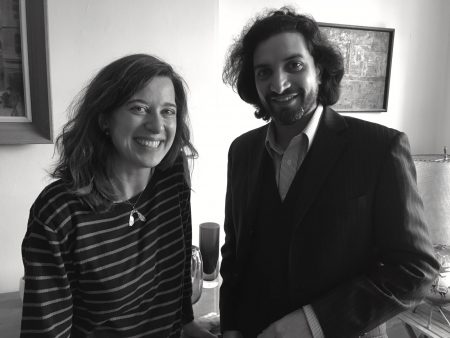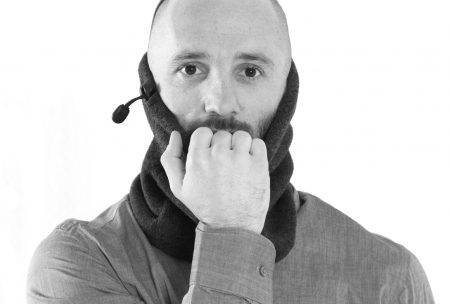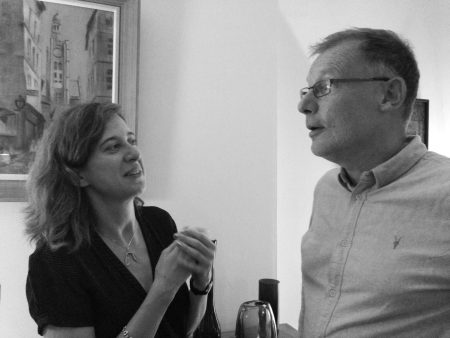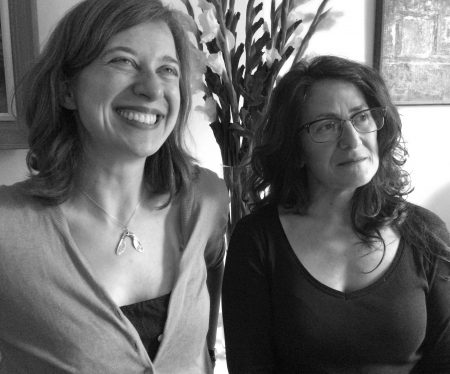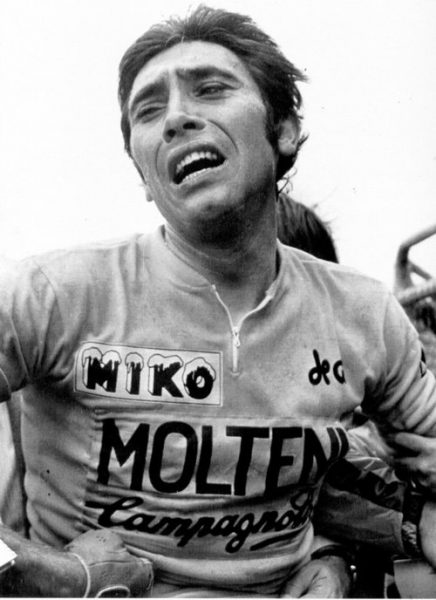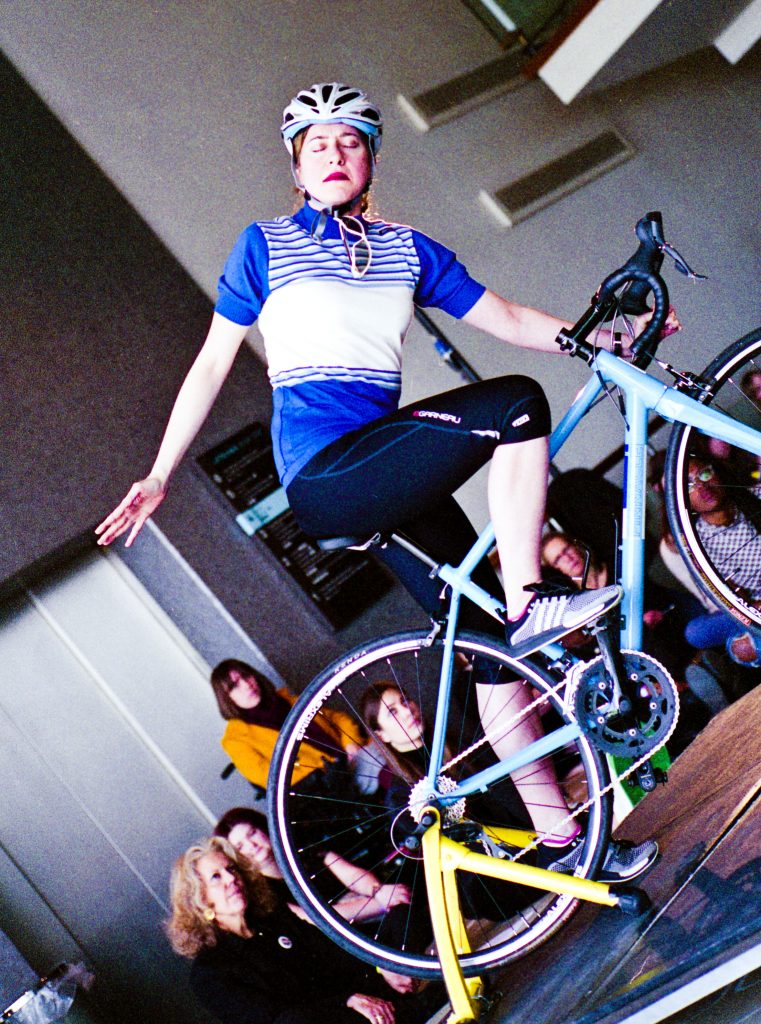by Karen Glossop
Karen is co-founder of Wishbone.
After a performance of Mountain High Valley Low at the Women of World festival, I noticed a young woman hovering just out of speaking distance, smiling but holding back. I guessed she wanted a conversation but didn’t want to make the first move.
People do often come up to speak to us after these mini pop-up performances. There aren’t any physical barriers to prevent them doing so: no curtain, no stage, no lighting distinction between “us and them”. So it’s easy for anyone to ask questions, make comments or get into a dialogue about mental health and other issues. Sometimes they want to talk about their own lives and challenges. So, when someone’s still shy, it can be a sign that they’re feeling emotional about something personal. And that’s not so easy.
We’ve been performing our 15 minute version of Mountain High Valley Low since November 2015, starting off in East London cycling and community cafes. After these pop-up forays amongst the laptops and lattes, we were offered the prestigious setting of Southbank Centre, first at Changing Minds (a festival exploring mental health and the arts) and then at the feminist festival, Women of the World. We occupied a foyer space near some lifts and the performance took place in daylight.
For Wishbone, the whole point of presenting work in this way – brief and (technically) simple – is to make theatre accessible to people who don’t think of theatre is their cup of tea. The goal is to give them an emotionally rewarding experience without much fuss. We hoped for engagement, and we got it.
What I wasn’t prepared for was the widespread assumption that the story was autobiographical.
Since starting Wishbone, Paul and I have believed that it’s ok to invent stories from scratch and to perform characters with whom – on the surface – we have nothing in common.
Our audiences have not criticised this approach. Nor have they challenged the fictitiousness of the fiction. In Scapegoat, we jointly performed the role of a femme fatale along the principles of a pantomime horse, and no one tried to use this device to extrapolate insights into our private lives.
However, it emerged that audiences were coming to Mountain High Valley Low with some different expectations.
Paul Murray and I co-created the project because we wanted to do something about vulnerability and endurance. Through our process, a shared conviction emerged that blending long-distance cycling and bipolar disorder provided us with the right metaphor to explore what we were compelled by.
Neither Paul nor I have ever suffered an acute, chronic mental illness such as affective bipolar disorder. We needed and wanted to be credible about the experience, so we did our research. We read extensively offline and online. One serendipitous discovery was a blog called Mad Bike Woman http://diaryofamadbikewoman.blogspot.co.uk . (Yes, really.) We also talked to diverse people who had experience of the illness – psychiatrists, carers and service users. Some of these were individuals we met through BipolarUK and other organisations. South London and Maudsley Arts were particularly helpful. We met a group of Experts By Experience in an eye-opening focus group. We discovered that as we spoke to various friends and acquaintances about our project, many people knew someone who had the illness. Most unexpectedly, someone I had known for years through my day job came out to me as having experienced bipolar disorder first hand.
Paul and I both confessed to each other that what we were learning about the experience of bipolar was uncannily familiar. We too, on occasion, had been possessed by moods, sometimes exhilarating and productive, at others ruminative and low. There even seemed to be parallels between mania and creative flow, between major depression and the self-loathing that accompanies work going badly or getting stuck.
On the other hand, after all our research and discussion and self-examination, affective bipolar disorder remains a foreign country. We listened to people relate real experiences that were utterly strange to us. I have never believed that I was in telepathic contact with my ex-boyfriend who was sending me mind messages to go to a hotel in Hebden Bridge where we would renew our relationship. I have never removed all the furniture from my flat and stacked it up in the street because it was safer there. I have never kept an electric carving knife handy in case my initial plan of poisoning myself with a cyanide solution didn’t work. I have never been sectioned. I have never been pumped full of drugs against my will. I have never ballooned in weight as a side-effect of the medication. I have never had to decide which I preferred: an inability to focus (another possible side-effect), or a potential relapse into a life-endangering manic episode.
But on stage, I feel entitled to pretend some of these things. That’s what fiction is: inventing and pretending. That’s what liberates it from the literal constraints of documentary. So why would anyone require a performer or storyteller to be autobiographical?
There’s a contemporary fashion for fixating on direct experience as the source of inspiration for artists and to endow the resulting work with authority, sometimes uncritically. As a culture, we fetishize this as authentic. If you can describe a drama as “based on a true story” you have a major selling point.
In other times, among other cultures, art earned its authority for different reasons. The artist was literally possessed, inspired by the gods and spirits who poured ideas into the artist’s mind and body. In our more secular, psychoanalytic age, we don’t like this external explanation, even though for many practitioners across different fields this is a pretty good metaphor for the subjective experience of creative flow. In our age, a new orthodoxy has taken hold about what constitutes authenticity. Autobiography is the real deal, it seems.
Of course, wonderful drama does sometimes come out of life history. But it isn’t the essential ingredient of artistic practice. Life tends to be sprawling and episodic, and not automatically meaningful. It takes hard graft and talent to lift it into art. Without this alchemy, all you have is base metal.
There must be something in the zeitgeist, because there’s another one-person show about bipolar disorder on the circuit at the moment. We went to see it at the Wolfson Theatre at King’s College, London, where it played to an audience of mainly service users and psychiatrists.
Living With The Lights On is powerful, moving and entertaining. Its author and actor Mark Lockyer is himself affected, and the events he relates in his show all happened to him. Yet he wears the autobiographical nature of his work lightly.
“It is all true, but if I had made it all up, it wouldn’t matter,” he said during the Q&A.
Yes, Lockyer has great material, but that’s not the reason his show is so good. The base metal of real life does seem to have a tight grip on other people’s perceptions though. The audience at the Wolsfon returned throughout the Q&Q session to Lockyer’s own experience of bipolar. It was as if they couldn’t or wouldn’t make a distinction between his life and his show. But surely there is one, even with such personal source material?
I certainly don’t want to dismiss the value of listening to those with lived experience. We do need to hear the voices of those with different lives and experiences, particularly those who are too often marginalised by stigma. And we need spaces where those voices can be heard unmediated by other considerations, like entertainment value. Social media in particular has been helpful for giving diverse individuals a platform to communicate with others. This enables visibility, empowerment, community and sometimes conflict too.
However, as soon as you create an artwork you are mediating experience, whether it’s your own or that of others. If you’re doing a good job, you’re dealing with a bigger truth than individual experience. This is what makes art resonant and universal.
So you would think that the personal history of the artist wasn’t relevant for the value of the artwork. Wouldn’t you?
BAFTA winner Denise Gough recently expressed frustration with being continually probed about whether she has a history of addiction because she has turned in a convincing performance as an addict in rehab in People, Places and Things. She’s pointed out that no one expects an actor playing a murderer to have done any real life murdering.
Generally those completely beyond the pale, like serial killers, are exempt, but there do seem to be categories where autobiographical experience has become an advantage if not a prerequisite. That’s when the drama is exploring the lives of people who exist at the borders of “normal”. It’s when the subject of the show is related to minorities for whatever reason – disability, ethnicity, abuse survival – that the mainstream media seems to be on the lookout for a drama behind the drama. Surely there’s no smoke without fire? It’s not clear how much this is a desire for a stamp of authority and how much this is a gossipy invasion of others’ privacy.
I think this is an uncomfortable and unnecessary demand. It puts a pressure on the artist to deliver more than the art. Some artists may invite the public into their personal lives. YBA star Tracy Emin, for one, has made her life history and her work inextricable, yet in her case the reward has been ambivalent at best. Emin at least has chosen this. There certainly shouldn’t be an obligation for artists to share in this way, or even to have personal material worth sharing.
Anyway, what constitutes marginal experience – having a mixed heritage? Being raped? – is itself uncertain.
Take mental illness, for instance. According to Mind, 1 in 4 people in the UK will experience a mental health problem each year. Not all of these problems will be on a grand scale, yet nonetheless distressing for anyone undergoing them. The numbers suggest that even though mental illness is stigmatised, it’s widespread. In truth, the distinction between “us and them” is shaky, and that realisation may create anxiety. The anxiety can in turn prompt in some people the desire to maintain and police divisions in all sorts of ways.
Autobiography fundamentalists, perhaps unwittingly, keep the experiences of others marginalised by downgrading the transcendent power of the imagination. Glamorising as well as demonising those who are the genuine article stops us looking in the mirror and recognising common humanity in all of us. Pretending is a way of exploring for both artist and audience. It’s about trusting our imagination as well as our lived experience.
There’s an argument for autobiography that’s comes from another source. And I find this argument more difficult to reject because of who is putting it forward.
The Dragon Café is a community café open to all, but in particular it is a safe, non-judgmental space for people who have mental illnesses to handle. As well as serving great lunch dishes, the café hosts many creative activities and well-being workshops. Most strikingly for the occasional visitor, it’s somewhere where people can and do disclose very personal stories.
We did a couple of performances here as a pop-up in December 2015. Because of the nature of the venue, we felt it was more important than ever to dispel any assumptions of autobiography upfront. The show was well-received. Many people in the audience resonated strongly with Josie’s story. But we found out later not everybody was happy with our project.
Our producer Dan took Paul and me aside and told us about something that had happened that he thought we should know about. Dan had overheard some remarks after the Q&A. Two women were exchanging views about the show, he said. He heard them agreeing that if the performer had never experienced bipolar first-hand she wasn’t the right person to portray someone who had. I’m not sure if this exact word was used in the conversation, but it sounded like the problem for them was appropriation. Dan told us how he intervened politely. He let them know that he’d overheard their response, and he suggested that they share their views with Paul and me. In the event, they didn’t want to speak directly with Paul or me about this, neither in the public Q&A nor one-to-one.
I was scrambled by emotions as I listened to Dan. I felt simultaneously indignant and guilty. It was distressing to face the fact that there were some among very constituency who we wanted to connect with most who were alienated by not so much by what we had made, but by who we were.
Most of all, I was frustrated that I that wasn’t going to have the opportunity of a dialogue with our critics. Although they’re entitled to keep their views private, I regret that they didn’t want to confront us directly, because we can’t learn from them if they won’t join in the conversation.
So here’s my guess as to what kind of case that they may have made against our project.
There are power structures that govern who gets a prominent voice in society and who doesn’t. It is not unusual to see people who are affected by mental illness patronised, demonised, or ridiculed. Just as identity politics helped changed mainstream attitudes to race, gender and sexuality, now mental health activists are having their turn.
Recently a movement has emerged representing the transgender community too. There are many ways in which transgender people choose to take up a more visible, empowered role in society. I don’t agree with all the tactics that activists use, such as “no platforming”, although I recognize the validity of such causes. There is a difference, though, between ensuring that anyone from a marginalized community – who wants to – does get the opportunity to tell their own story, and policing who gets to tell stories. As transgender becomes more explored on stage and screen, there have been real breakthroughs in casting transgender people in transgender roles. There have also been cis actors playing transgender roles, notably Eddie Redmayne in The Danish Girl. I’m not clear why anyone would believe the latter diminishes the former. There is room for many perspectives, many voices, many representations. As long as there is dialogue, as long as there is sensitivity, this plurality encourages us to be inclusive and grow as a civilization.
I don’t want to stop anybody affected by bipolar creating theatre, film, music or any other art explicitly fuelled by their bipolar experience. But I also demand the right as a dramatist and a performer to pretend anything I like. If Wishbone’s work is untruthful or poorly executed, lacking in emotion or interest, tell us. Judge us on the quality of our art, not on our mental health histories.
Paul and I are not at the sharp end of stigma but neither are we perpetuating it. Our project is not about superimposing our voices over others, or silencing them. We have never claimed to be speaking for people affected by bipolar. We created the show respectfully and in collaboration with a range of people concerned with bipolar affective disorder. We have looked at bipolar from several sides if not from the inside.
It’s most fervently about conversations.
I still don’t have absolute certainty about the experience of bipolar. But I have learned something about my own vulnerability and capacity for endurance by imaginatively inhabiting bipolar disorder. I hope Wishbone’s audiences discover something too, whatever that is.
Speaking of conversations, back at the Southbank Centre, at the WoW festival, the young woman did eventually come up to me. She was tremulous, eyes brimming, although she was still smiling.
Feeling cautious about what I might trigger, I asked her: “Did the show have some resonance for you?”
Even as I spoke, my choice of words sounded stilted to me.
She nodded and said, “But I don’t want to talk about myself, after you’ve shared so much.”
I was instantly filled with alarm. Did she mean she was moved by my performance as actor, or was she inferring that the show was autobiographical? Should I wait for her to be more explicit, or should I rush in with disclaimers? Would it be overkill to begin a debate about artistic license? What should I say?
Then I realized I didn’t need to check her understanding or defend my position. We already had a connection, and there was nothing more that I needed to prove. It was a physical sensation, as if my hands had been gripped into fists and now they were relaxing. I’d already done my part and now all I needed to do was acknowledge that she had done hers too.
“Thank-you,” I said. “Thank-you for watching.”
